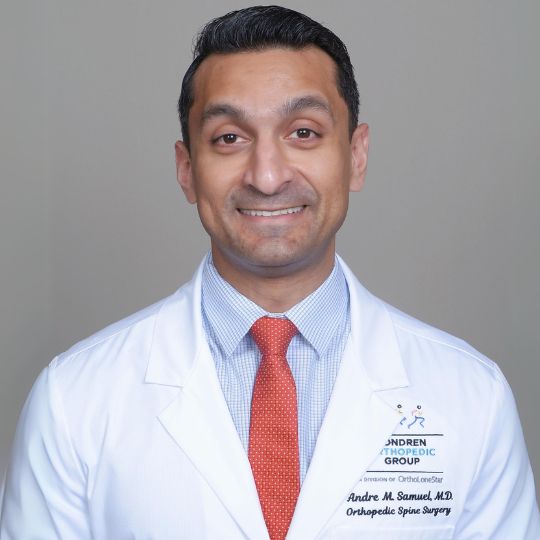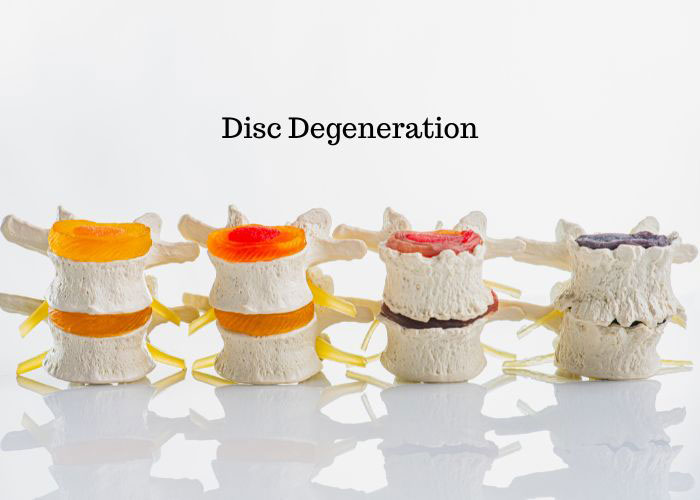Lumbar Disc Degeneration Specialist
If lower back pain is slowing you down, lumbar degenerative disc disease could be the culprit. Don’t let pain dictate your life. Take the first step towards a healthier spine. Doctor Andre M. Samuel, orthopedic spine specialist, treats patients in the Clear Lake, Houston, Sugar Land, TX area who have been diagnosed with lumbar degenerative disc disease and are experiencing lower back pain. Contact Dr. Samuel’s team today!

What is Lumbar Degenerative Disc Disease?
As we age, the intervertebral discs in our spine change, losing hydration and elasticity. This process may lead to lumbar degenerative disc disease. The affected disc or discs in the lower back may pinch or compress nerves in the lumbar spine, causing lower back pain and discomfort in other areas, including the hips and legs. This degeneration compromises the discs’ ability to absorb shocks and maintain spinal flexibility, affecting overall mobility and comfort. Since this condition affects most people over a certain age, it’s not considered a “true” disease. Treatments are available to help patients manage symptoms and alleviate pain. Doctor Andre M. Samuel, orthopedic spine specialist, treats patients in the Clear Lake, Houston, Sugar Land, TX area suffering from lumbar degenerative disc disease.

What are the common causes of Lumbar Degenerative Disc Disease?
Several factors can contribute to the deterioration of the intervertebral discs in the lower back – leading to lumbar degenerative disc disease. They include:
- Aging: Intervertebral discs naturally break down as we age.
- Genetic predisposition: Individuals with a family history of spine problems develop the condition more often.
- Mechanical stress: Heavy lifting, bending, twisting, and prolonged sitting can accelerate disc wear and tear.
- Injury: Falls and accidents can cause immediate damage to discs, leading to or exacerbating degeneration.
- Smoking: Smoking reduces blood flow to the spine, contributing to their degeneration.
Other issues, such as obesity and poor posture, can also lead to the progression of lumbar degenerative disc disease. Lifestyle changes and medical intervention can often provide symptom relief.
What are the first signs or symptoms of Lumbar Degenerative Disc Disease?
Early symptoms of lumbar degenerative disc disease may include persistent or intermittent lower back pain that can worsen when sitting, bending, or lifting. Relief may come from walking or changing positions. Symptoms can also radiate to the buttocks, thighs, or legs. A patient may also experience numbness, tingling, or muscle weakness. Morning stiffness is also common. Symptoms vary in intensity from person to person and can range from mild discomfort to severe pain and mobility issues. Consulting with Dr. Samuel is crucial for an accurate diagnosis and appropriate management plan.
How is lumbar degenerative disc disease diagnosed?
Dr. Samuel takes a thorough medical history from each patient and conducts an extensive physical exam to help diagnose lumbar degenerative disc disease. He may also use a series of imaging tests such as X-rays and an MRI to get a more detailed view of the disc degeneration that may be happening in the lower spine. A discography, which shoots dye into the area, can also help determine which disc is causing the pain. Once Dr. Samuel makes a diagnosis – he and his team develop a detailed treatment plan.
What is the treatment for lumbar degenerative disc disease?
Non-surgical treatments are often the first line of defense to ease symptoms caused by lumbar degenerative disc disease. They include:
- Physical therapy
- Over-the-counter pain relievers such as NSAIDs and acetaminophen
- Muscle relaxants
- Nerve pain medications
- Epidural steroid injections
Losing weight and increasing exercise may also be recommended to help ease symptoms. If conservative treatments fail and the patient experiences continued pain, disability, or neurological symptoms, Dr. Samuel may recommend surgical options. They include:
- Discectomy: Removal of the damaged portion of a disc.
- Laminectomy: Removal of part of the bone that’s pressing on nerves.
- Spinal Fusion: Joining two or more vertebrae together to stabilize the spine.
- Artificial Disc Replacement: Replace the degenerated disc with an artificial one.
Dr. Samuel’s surgical recommendation depends on how severe the symptoms are, which discs are causing trouble, and a patient’s overall health. Before the surgery, each patient talks with Dr. Samuel about the pros and cons of the procedure.


